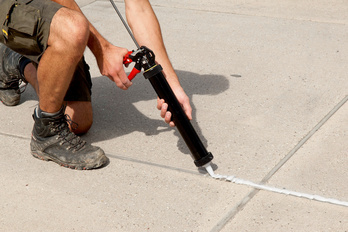For detailed information, other images and documents, please select individual articles from the following table.
Floor joint sealant
Single-component, solvent-free PU sealant for high-stress joints, both indoors and outdoors. Hazard label not required
Register now and access more than 125,000 products


Variants
Register now and access more than 125,000 products
Very low emissions
Tested emissions properties
Approved for use with foodstuffs (ISEGA certificate)
Suitable for sealing in areas where food is processed or stored
Elastic
- Compensates different material expansions
- Dampens vibrations and noise
Prevents contact corrosion
Bubble-free curing system
Silicone-free
Tested in accordance with EN 15651 Part 4
- Fire behaviour: Class E
- Resistance to tearing: Passed
- Volume loss: ≤ 10%
- Tensile behaviour under pre-stress: Passed
- Adhesion/expansion after being immersed in water for 28 days:
- Passed
- Adhesion/expansion after being immersed in salt water for 28 days: Passed
- Tensile behaviour under pre-stress at -30°C: Passed
- Durability: Passed
- Must not be used for glass sealing or in swimming pools
- Curing time of 14 days at approx. 20 °C material and floor temperature up to full load capacity
- The colour can be affected by environmental factors and external influences, such as chemicals, high temperature, UV radiation, unsuitable paints or smoothing agents. These potential changes in colour do not affect the technical and protective properties of the product.
- Elastic sealants must never be painted. Coats of paint have limited elasticity and can crack and flake when movement occurs in the joint.
- Colour changes due to intolerances cannot be excluded. For sealant-compatible coats of paint, the joint edges should be trimmed by a maximum of 1 mm (test in accordance with DIN 52 452-4).
- Do not use on bituminous or other surfaces that can bleed oil or plasticisers, e.g. EPDM or natural rubber or carry out preliminary tests
- Good chemical and mechanical resistance. It must be ensured that joints cannot be destroyed with hard cleaning brushes. Chemicals used may reduce resistance.
- All tools and processing accessories must be immediately cleaned with adhesive remover. Hardened sealant residues can only be removed mechanically.
- In its uncured state, must not be mixed or come into contact with substances that react with isocyanate. Otherwise the final reaction and linking of the material will be impaired or prevented. In particular alcohols that are a component of spirit, thinner, cleaning agent and formwork oil must be avoided.

The floor joint sealant is particularly suitable for joining movement and connection joints indoors and outdoors in food-related areas. Suitable for floor joints in concrete and screed exposed to static loads or rolling traffic, e.g. joints in warehouses, production halls, parking decks, yard areas, underground garages, for tiled floors in entrance halls and stairwells.
- The joint flanks must be load-bearing, stable, clean, dry and free from oil, grease and loose components, concrete slurry, paint, hydrophobing agents and anti-graffiti coatings
- After surface preparation and insertion of a tightly fitting closed-cell PE round cord, the joint sealant is inserted into the prepared joint with a suitable gun. It must be ensured that the sealant is inserted with no bubbles or cavities and that there is complete contact with joint edges. Afterwards, the joint surface is levelled with a suitable smoothing tool or trowel. The sealant must be pressed onto the adhesive surfaces and the back-fill material.
- When required the surface can be smoothed with Würth Sealant smoothing agent
- Please observe the "General Notes on Application for Sealants" overview sheet. Further information in the technical data sheet.
Select RAL-colour code
!! NOTE: On-screen visualisation of the colour differs from real colour shade!!







